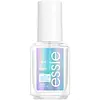What's inside
What's inside
 Key Ingredients
Key Ingredients

 Benefits
Benefits

 Concerns
Concerns

 Ingredients Side-by-side
Ingredients Side-by-side

Ethyl Acetate
PerfumingButyl Acetate
MaskingNitrocellulose
Propyl Acetate
PerfumingTributyl Citrate
SolventIsopropyl Alcohol
SolventTosylamide/Epoxy Resin
Adipic Acid/Neopentyl Glycol/Trimellitic Anhydride Copolymer
Stearalkonium Hectorite
Gel FormingAcrylates Copolymer
Benzophenone-1
UV AbsorberDimethyl Sulfone
SolventCalcium Sodium Borosilicate
Synthetic Fluorphlogopite
Hydrogenated Acetophenone/Oxymethylene Copolymer
Dimethicone
EmollientCitric Acid
BufferingOxidized Polyethylene
Acetyl Tributyl Citrate
MaskingCI 77120
Cosmetic ColorantAlumina
AbrasiveCalcium Aluminum Borosilicate
Colophonium
Silica
AbrasiveWater
Skin ConditioningTin Oxide
AbrasiveMagnesium Silicate
AbsorbentCalcium Pantothenate
Camellia Sinensis Leaf Extract
AntimicrobialAluminum Hydroxide
EmollientPhthalic Anhydride/Glycerin/Glycidyl Decanoate Copolymer
Acetone
SolventCI 77002
Cosmetic ColorantCI 77891
Cosmetic ColorantMica
Cosmetic ColorantCI 77491
Cosmetic ColorantCI 77499
Cosmetic ColorantCI 15880
Cosmetic ColorantCI 19140
Cosmetic ColorantCI 15850
Cosmetic ColorantCI 77400
Cosmetic ColorantCI 77288
Cosmetic ColorantCI 42090
Cosmetic ColorantCI 77510
Cosmetic ColorantCI 77000
Cosmetic ColorantCI 77163
Cosmetic ColorantCI 77266
Cosmetic ColorantEthyl Acetate, Butyl Acetate, Nitrocellulose, Propyl Acetate, Tributyl Citrate, Isopropyl Alcohol, Tosylamide/Epoxy Resin, Adipic Acid/Neopentyl Glycol/Trimellitic Anhydride Copolymer, Stearalkonium Hectorite, Acrylates Copolymer, Benzophenone-1, Dimethyl Sulfone, Calcium Sodium Borosilicate, Synthetic Fluorphlogopite, Hydrogenated Acetophenone/Oxymethylene Copolymer, Dimethicone, Citric Acid, Oxidized Polyethylene, Acetyl Tributyl Citrate, CI 77120, Alumina, Calcium Aluminum Borosilicate, Colophonium, Silica, Water, Tin Oxide, Magnesium Silicate, Calcium Pantothenate, Camellia Sinensis Leaf Extract, Aluminum Hydroxide, Phthalic Anhydride/Glycerin/Glycidyl Decanoate Copolymer, Acetone, CI 77002, CI 77891, Mica, CI 77491, CI 77499, CI 15880, CI 19140, CI 15850, CI 77400, CI 77288, CI 42090, CI 77510, CI 77000, CI 77163, CI 77266
Butyl Acetate
MaskingEthyl Acetate
PerfumingNitrocellulose
Trimethyl Pentanyl Diisobutyrate
Isopropyl Alcohol
SolventAdipic Acid/Neopentyl Glycol/Trimellitic Anhydride Copolymer
Polyvinyl Butyral
Stearalkonium Hectorite
Gel FormingAcrylates Copolymer
Benzophenone-3
UV AbsorberKaolin
AbrasiveRetinyl Palmitate
Skin ConditioningCalcium Pantothenate
Hydrolyzed Wheat Protein
Skin ConditioningPanthenol
Skin ConditioningCitric Acid
BufferingCI 77891
Cosmetic ColorantCI 15850
Cosmetic ColorantButyl Acetate, Ethyl Acetate, Nitrocellulose, Trimethyl Pentanyl Diisobutyrate, Isopropyl Alcohol, Adipic Acid/Neopentyl Glycol/Trimellitic Anhydride Copolymer, Polyvinyl Butyral, Stearalkonium Hectorite, Acrylates Copolymer, Benzophenone-3, Kaolin, Retinyl Palmitate, Calcium Pantothenate, Hydrolyzed Wheat Protein, Panthenol, Citric Acid, CI 77891, CI 15850
Ingredients Explained
These ingredients are found in both products.
Ingredients higher up in an ingredient list are typically present in a larger amount.
Acrylates Copolymer is used as a film-forming agent and texture enhancer.
After applied, Acrylates Copolymer forms a thin film cover that helps skin feel more soft. It can help sunscreens become more water-resistant.
It is also used to make a product more thick.
Learn more about Acrylates CopolymerWe don't have a description for Adipic Acid/Neopentyl Glycol/Trimellitic Anhydride Copolymer yet.
We don't have a description for Butyl Acetate yet.
Calcium Pantothenate is calcium salt from Vitamin B5. It can be naturally found in plants and animals.
Calcium Pantothenate is a potent antioxidant. Antioxidants help fight free-radical molecules. Free-radical molecules are capable of damaging our cells and other genetic material. Antioxidants help stabilize free-radicals by donating extra electrons. This may help reduce the signs of aging.
Our bodies use Calcium Pantothenate for various metabolic functinos. These functions include metabolizing carbohydrates, proteins, and fatty acids.
Learn more about Calcium PantothenateCi 15850 is the pigment color red. It is an azo dye and created synthetically.
Azo dyes need to be thoroughly purified before use. This allows them to be more stable and longer-lasting.
This ingredient is common in foundations, lipsticks, and blushes. This color is described as brown/orangey red.
It has many secondary names such as Red 6 and Red 7. According to a manufacturer, Red 6 usually contains aluminum.
Learn more about CI 15850Ci 77891 is a white pigment from Titanium dioxide. It is naturally found in minerals such as rutile and ilmenite.
It's main function is to add a white color to cosmetics. It can also be mixed with other colors to create different shades.
Ci 77891 is commonly found in sunscreens due to its ability to block UV rays.
Learn more about CI 77891Citric Acid is an alpha hydroxy acid (AHA) naturally found in citrus fruits like oranges, lemons, and limes.
Like other AHAs, citric acid can exfoliate skin by breaking down the bonds that hold dead skin cells together. This helps reveal smoother and brighter skin underneath.
However, this exfoliating effect only happens at high concentrations (20%) which can be hard to find in cosmetic products.
Due to this, citric acid is usually included in small amounts as a pH adjuster. This helps keep products slightly more acidic and compatible with skin's natural pH.
In skincare formulas, citric acid can:
While it can provide some skin benefits, research shows lactic acid and glycolic acid are generally more effective and less irritating exfoliants.
Most citric acid used in skincare today is made by fermenting sugars (usually from molasses). This synthetic version is identical to the natural citrus form but easier to stabilize and use in formulations.
Read more about some other popular AHA's here:
Learn more about Citric AcidEthyl Acetate is a fragrance.
Isopropyl Alcohol is more commonly known as rubbing alcohol. It is most commonly used as a solvent, meaning it helps other ingredients dissolve.
This ingredient is an astringent alcohol. Astringent alcohols may also irritate skin as they high amounts may strip away your skin's natural oils.
Other types of astringent alcohols include:
According to the National Rosacea Society based in the US, you should be mindful of products with these alcohols in the top half of ingredients.
Any type of sanitizing product will have high amounts of alcohol to help kill bacteria and viruses.
Learn more about Isopropyl AlcoholWe don't have a description for Nitrocellulose yet.
Stearalkonium Hectorite is a clay-derived ingredient used to thicken a product and help create a gel-like texture.